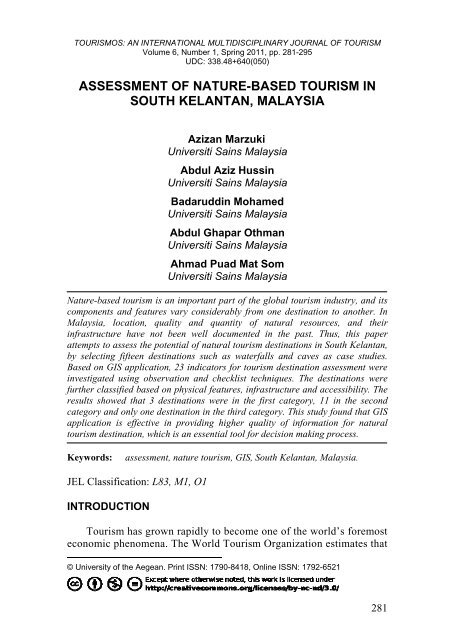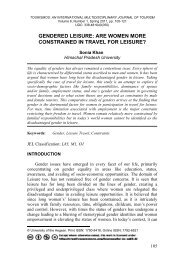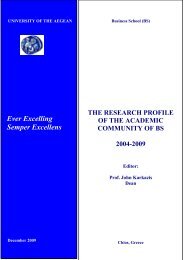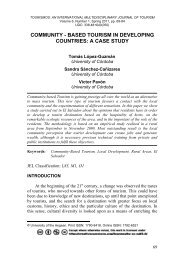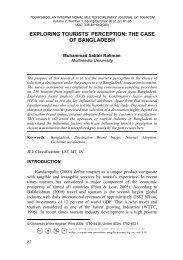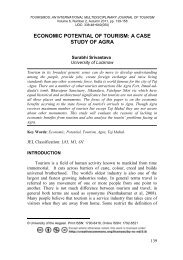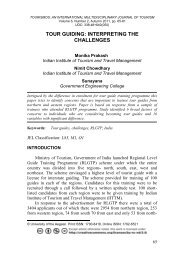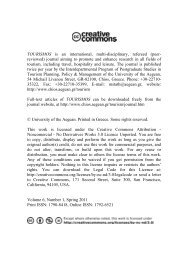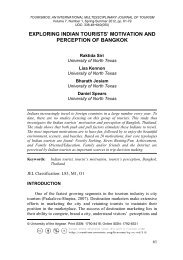assessment of nature-based tourism in south kelantan, malaysia
assessment of nature-based tourism in south kelantan, malaysia
assessment of nature-based tourism in south kelantan, malaysia
You also want an ePaper? Increase the reach of your titles
YUMPU automatically turns print PDFs into web optimized ePapers that Google loves.
TOURISMOS: AN INTERNATIONAL MULTIDISCIPLINARY JOURNAL OF TOURISM<br />
Volume 6, Number 1, Spr<strong>in</strong>g 2011, pp. 281-295<br />
UDC: 338.48+640(050)<br />
ASSESSMENT OF NATURE-BASED TOURISM IN<br />
SOUTH KELANTAN, MALAYSIA<br />
Azizan Marzuki 1<br />
Universiti Sa<strong>in</strong>s Malaysia<br />
Abdul Aziz Huss<strong>in</strong><br />
Universiti Sa<strong>in</strong>s Malaysia<br />
Badarudd<strong>in</strong> Mohamed<br />
Universiti Sa<strong>in</strong>s Malaysia<br />
Abdul Ghapar Othman<br />
Universiti Sa<strong>in</strong>s Malaysia<br />
Ahmad Puad Mat Som<br />
Universiti Sa<strong>in</strong>s Malaysia<br />
Nature-<strong>based</strong> <strong>tourism</strong> is an important part <strong>of</strong> the global <strong>tourism</strong> <strong>in</strong>dustry, and its<br />
components and features vary considerably from one dest<strong>in</strong>ation to another. In<br />
Malaysia, location, quality and quantity <strong>of</strong> natural resources, and their<br />
<strong>in</strong>frastructure have not been well documented <strong>in</strong> the past. Thus, this paper<br />
attempts to assess the potential <strong>of</strong> natural <strong>tourism</strong> dest<strong>in</strong>ations <strong>in</strong> South Kelantan,<br />
by select<strong>in</strong>g fifteen dest<strong>in</strong>ations such as waterfalls and caves as case studies.<br />
Based on GIS application, 23 <strong>in</strong>dicators for <strong>tourism</strong> dest<strong>in</strong>ation <strong>assessment</strong> were<br />
<strong>in</strong>vestigated us<strong>in</strong>g observation and checklist techniques. The dest<strong>in</strong>ations were<br />
further classified <strong>based</strong> on physical features, <strong>in</strong>frastructure and accessibility. The<br />
results showed that 3 dest<strong>in</strong>ations were <strong>in</strong> the first category, 11 <strong>in</strong> the second<br />
category and only one dest<strong>in</strong>ation <strong>in</strong> the third category. This study found that GIS<br />
application is effective <strong>in</strong> provid<strong>in</strong>g higher quality <strong>of</strong> <strong>in</strong>formation for natural<br />
<strong>tourism</strong> dest<strong>in</strong>ation, which is an essential tool for decision mak<strong>in</strong>g process.<br />
Keywords:<br />
<strong>assessment</strong>, <strong>nature</strong> <strong>tourism</strong>, GIS, South Kelantan, Malaysia.<br />
JEL Classification: L83, M1, O1<br />
INTRODUCTION<br />
Tourism has grown rapidly to become one <strong>of</strong> the world’s foremost<br />
economic phenomena. The World Tourism Organization estimates that<br />
© University <strong>of</strong> the Aegean. Pr<strong>in</strong>t ISSN: 1790-8418, Onl<strong>in</strong>e ISSN: 1792-6521<br />
281
Azizan Marzuki, Abdul Aziz Huss<strong>in</strong>, Badarudd<strong>in</strong> Mohamed, Abdul Ghapar Othman &<br />
Ahmad Puad Mat Som<br />
<strong>in</strong>ternational tourist arrivals <strong>in</strong> 2020 will reach to 1.6 billion<br />
worldwide and <strong>tourism</strong> receipts will exceed more than US$2 trillion<br />
(WTO, 2000). Accord<strong>in</strong>g to the International Eco<strong>tourism</strong> Society<br />
(2000), about 60% <strong>of</strong> <strong>in</strong>ternational tourists can be considered as<br />
<strong>nature</strong>-<strong>based</strong> tourists. A study done by the World Resources Institute<br />
also claims that this type <strong>of</strong> <strong>tourism</strong> is <strong>in</strong>creas<strong>in</strong>g at an annual rate <strong>of</strong><br />
10% to 30% and will cont<strong>in</strong>ue to play an important role <strong>in</strong><br />
<strong>in</strong>ternational <strong>tourism</strong> (Re<strong>in</strong>gold, 1993).<br />
The term <strong>nature</strong>-<strong>based</strong> <strong>tourism</strong> is generally applied to <strong>tourism</strong><br />
activities depend<strong>in</strong>g on the use <strong>of</strong> natural resources which rema<strong>in</strong> <strong>in</strong> a<br />
relatively undeveloped state, <strong>in</strong>clud<strong>in</strong>g scenery, topography,<br />
waterways, vegetation, wildlife, and cultural heritage (Ceballos-<br />
Lascura<strong>in</strong>, 1996). Millions <strong>of</strong> people travel to see and experience<br />
natural environments each year, and the scale <strong>of</strong> such movements<br />
leads, <strong>in</strong>evitably, to some disturbance or damage to visited sites.<br />
While such damage is attributable directly or <strong>in</strong>directly to tourists and<br />
their activities, it is <strong>of</strong>ten unclear whether their actual behaviour is<br />
responsible for the major negative impacts on <strong>nature</strong> and related<br />
activities such as the construction and development <strong>of</strong> <strong>in</strong>frastructure<br />
and facilities (Deng et al., 2002). Nevertheless, it is tourists who are<br />
usually identified as caus<strong>in</strong>g destruction, particularly <strong>in</strong> develop<strong>in</strong>g<br />
countries. This begs the question as to whether this <strong>tourism</strong> type is<br />
compatible with the natural environment and whether it can assist <strong>in</strong><br />
the resolution <strong>of</strong> problems associated with the exploitation <strong>of</strong> such<br />
resources.<br />
NATURAL TOURISM DESTINATION ASSESSMENT<br />
Despite the critical role played by the quality <strong>of</strong> the dest<strong>in</strong>ation<br />
experience <strong>in</strong> determ<strong>in</strong><strong>in</strong>g whether tourists are satisfied and whether<br />
their expectations have been met, most <strong>nature</strong>-<strong>based</strong> studies focus on<br />
tourist demand rather than on dest<strong>in</strong>ations. As this form <strong>of</strong> <strong>tourism</strong><br />
cont<strong>in</strong>ues to grow, areas such as national parks will be placed under<br />
<strong>in</strong>creas<strong>in</strong>g pressure. If their managers are to function effectively, it is<br />
essential that protected and natural areas are evaluated and rated with<br />
a view to communicat<strong>in</strong>g the pr<strong>in</strong>ciples <strong>of</strong> susta<strong>in</strong>able development<br />
and to ensur<strong>in</strong>g an appropriate match between tourists’ expectations<br />
and experiences (Deng et al., 2002). The European ’blue flag’ rat<strong>in</strong>g<br />
system, us<strong>in</strong>g this symbol to endorse high quality assets, is an<br />
example <strong>of</strong> such an approach. Beaches, for example, which constitute<br />
an asset central to dest<strong>in</strong>ations and tourist experiences, are identified<br />
282
TOURISMOS: AN INTERNATIONAL MULTIDISCIPLINARY JOURNAL OF TOURISM<br />
Volume 6, Number 1, Spr<strong>in</strong>g 2011, pp. 281-295<br />
UDC: 338.48+640(050)<br />
by a particular symbol when they have been evaluated as safe and<br />
clean (Moore and Carter, 1991). It is quite conceivable that resort<br />
dest<strong>in</strong>ations and for that matter some countries will be rated <strong>in</strong> respect<br />
to environmental safety standards. Environmental safety is, however,<br />
only one aspect <strong>of</strong> the management <strong>of</strong> protected and natural areas and<br />
a more comprehensive evaluation and rat<strong>in</strong>g system will be needed if<br />
such dest<strong>in</strong>ations are to fulfil and reta<strong>in</strong> their potential. The<br />
development <strong>of</strong> a formal evaluation and rat<strong>in</strong>g system for protected<br />
and natural areas is worthwhile for several reasons.<br />
First, tourists will <strong>of</strong>ten visit more than one dest<strong>in</strong>ation dur<strong>in</strong>g a<br />
trip. They will typically experience a range <strong>of</strong> natural and cultural<br />
environments (Dodds & Butler, 2010). The World Tourism<br />
Organization has noted that <strong>in</strong> practice only a small proportion <strong>of</strong><br />
tourists travel to exclusively experience <strong>nature</strong> or culture. Despite the<br />
upsurge <strong>in</strong> awareness and <strong>in</strong>terest, avid eco-tourists will rema<strong>in</strong> a<br />
small market segment, which has been described as ’hard’ eco-tourists<br />
(Blamey, 1995). Ornithologists, botanists or geologists are likely<br />
candidates for the ’hard’ eco-tourist category when they pursue their<br />
passion, whereas sightseers or photographers would more commonly<br />
fall under the category <strong>of</strong> ’s<strong>of</strong>t’ eco-tourists. Resort tourists who opt<br />
to spend a day visit<strong>in</strong>g and learn<strong>in</strong>g about a reef or ra<strong>in</strong>forest habitat<br />
would typically fall <strong>in</strong>to the ’s<strong>of</strong>t’ category. Tak<strong>in</strong>g this view to its<br />
logical conclusion, all mass tourists are potential <strong>nature</strong>-<strong>based</strong> ones<br />
and may be categorized as such when spend<strong>in</strong>g a period as short as a<br />
day or even a few hours <strong>in</strong> an eco<strong>tourism</strong> area. For such groups who<br />
may not consider themselves as such, the evaluation and rat<strong>in</strong>g <strong>of</strong><br />
national parks provides an opportunity to become <strong>in</strong>formed about the<br />
importance <strong>of</strong> susta<strong>in</strong>able development through the enhancement <strong>of</strong><br />
their awareness and understand<strong>in</strong>g <strong>of</strong> the dest<strong>in</strong>ation.<br />
A second reason is that <strong>nature</strong>-<strong>based</strong> <strong>tourism</strong> is dependent upon the<br />
quality <strong>of</strong> the environment, more than is the case with other forms (Boyd,<br />
Chard and Butler, 1996). Scenically appeal<strong>in</strong>g environments <strong>of</strong>ten<br />
<strong>in</strong>corporate aspects such as local community, roads and tracks, visitor<br />
facilities and attractions, both major and peripheral (Rich<strong>in</strong>s & Scar<strong>in</strong>ci,<br />
2009). Where dest<strong>in</strong>ations are well managed and tourists are<br />
knowledgeable and aware, these elements complement the natural<br />
attributes and contribute to satisfaction. If they were provided with an<br />
evaluation and rat<strong>in</strong>g for each <strong>of</strong> the elements encountered <strong>in</strong> such areas,<br />
they might be better equipped to assess protected and natural areas just as<br />
they are able to anticipate what may be expected from hotels by virtue <strong>of</strong><br />
their category or star rat<strong>in</strong>g.<br />
283
Azizan Marzuki, Abdul Aziz Huss<strong>in</strong>, Badarudd<strong>in</strong> Mohamed, Abdul Ghapar Othman &<br />
Ahmad Puad Mat Som<br />
The third reason is that the importance <strong>of</strong> pric<strong>in</strong>g as a park’s<br />
management issue is grow<strong>in</strong>g. As Buckley (1998:20) has po<strong>in</strong>ted out,<br />
‘management costs for national parks will <strong>in</strong>crease because <strong>of</strong> <strong>in</strong>creas<strong>in</strong>g<br />
<strong>tourism</strong> visitation rates. Park entrance fees and commercial operator<br />
permit fees will <strong>in</strong>crease as park managers endeavour to recover their<br />
costs’. There is a strong argument <strong>in</strong> favour <strong>of</strong> relat<strong>in</strong>g price levels more<br />
closely with the level <strong>of</strong> experience encountered <strong>in</strong> protected and natural<br />
areas (Dritsaki, 2009). Tourists accept this connection <strong>in</strong> the case <strong>of</strong> fivestar<br />
hotels which charge more than three-star hotels. The application <strong>of</strong><br />
the commercial rationale is certa<strong>in</strong>ly more controversial <strong>in</strong> the case <strong>of</strong><br />
natural resources. But as the volume <strong>of</strong> visitation <strong>in</strong>creases, the parallel<br />
with other <strong>tourism</strong> facilities will become <strong>in</strong>creas<strong>in</strong>gly evident (Deng et<br />
al., 2002).<br />
As to the program evaluation process, it may comprise four steps:<br />
determ<strong>in</strong><strong>in</strong>g goals, specify<strong>in</strong>g objectives, operational program, and<br />
measur<strong>in</strong>g program effectiveness (Theobald, 1979). Lundgren and Farrell<br />
(1985) propose that such evaluation is a process <strong>of</strong> determ<strong>in</strong><strong>in</strong>g value by<br />
compar<strong>in</strong>g results with objectives and <strong>of</strong> judg<strong>in</strong>g how well they have been<br />
met <strong>in</strong> both a qualitative and quantitative sense. Evaluation <strong>in</strong>volves<br />
<strong>in</strong>put, process, output and feedback. Accord<strong>in</strong>g to Mitchell (1989), Moss<br />
and Nickl<strong>in</strong>g (1980), Bishop and Gimblett (2000), natural <strong>tourism</strong><br />
dest<strong>in</strong>ation could be assessed <strong>based</strong> on attraction or panoramic view by<br />
us<strong>in</strong>g three landscape <strong>assessment</strong> approaches:<br />
• Landscape survey <strong>in</strong>volv<strong>in</strong>g an expert team to identify a good<br />
aerial view <strong>based</strong> on site analysis, topography and other<br />
<strong>in</strong>formation.<br />
• Landscape <strong>in</strong>ventory to identify and record natural features.<br />
• Us<strong>in</strong>g Geographical Information System (GIS).<br />
In general, all approaches are important and practical <strong>in</strong> assess<strong>in</strong>g<br />
natural <strong>tourism</strong> dest<strong>in</strong>ation. However, due to several limitations <strong>in</strong> the<br />
length <strong>of</strong> study with a small research grant, this study has deliberately<br />
determ<strong>in</strong>ed to apply GIS application <strong>in</strong> <strong>tourism</strong> dest<strong>in</strong>ation <strong>assessment</strong><br />
process <strong>in</strong> South Kelantan, Malaysia. As stated by Milam and Jones<br />
(1995), GIS approach could potentially speed up data analysis process<br />
and reduce the length <strong>of</strong> the study. In fact, GIS could improve and<br />
<strong>in</strong>crease the quality <strong>of</strong> f<strong>in</strong>al product (Burrough, 1986).<br />
NATURAL TOURISM DESTINATION IN MALAYSIA<br />
Malaysia, <strong>in</strong> general, has 54 protected areas <strong>of</strong> more than 1,000<br />
hectares, totall<strong>in</strong>g 1,485 million hectares or about 4.5 per cent <strong>of</strong> the<br />
284
TOURISMOS: AN INTERNATIONAL MULTIDISCIPLINARY JOURNAL OF TOURISM<br />
Volume 6, Number 1, Spr<strong>in</strong>g 2011, pp. 281-295<br />
UDC: 338.48+640(050)<br />
country’s land surface. They <strong>in</strong>clude 28 strict <strong>nature</strong> reserves<br />
(<strong>in</strong>accessible to <strong>tourism</strong> activity), 16 national parks or their state-level<br />
equivalents, n<strong>in</strong>e managed <strong>nature</strong> reserves or wildlife sanctuaries and one<br />
protected landscape. Recent statistics reveal that <strong>nature</strong>-<strong>based</strong> activities<br />
are the fastest grow<strong>in</strong>g <strong>tourism</strong> product <strong>in</strong> Malaysia, and it is estimated<br />
that 10% <strong>of</strong> Malaysia’s <strong>tourism</strong> revenue <strong>in</strong> 2000 orig<strong>in</strong>ated from<br />
eco<strong>tourism</strong>.<br />
The National Eco<strong>tourism</strong> Plan (NEP) was drafted <strong>in</strong> 1996 to assist<br />
the federal and state governments <strong>in</strong> develop<strong>in</strong>g Malaysia’s eco<strong>tourism</strong><br />
potential. The Plan identifies 52 project suggestions, relat<strong>in</strong>g to 48 areas<br />
and four suggestions that are not site-specific. About 20 sites <strong>in</strong><br />
Pen<strong>in</strong>sular Malaysia, Sabah and Sarawak account for the vast majority <strong>of</strong><br />
eco<strong>tourism</strong> by foreign and domestic tourists. The Plan is <strong>in</strong>tended to serve<br />
both as an appropriate <strong>in</strong>strument with<strong>in</strong> the overall susta<strong>in</strong>able<br />
development <strong>of</strong> Malaysia and the economy as a whole, and as an effective<br />
tool for conservation <strong>of</strong> natural and cultural heritage <strong>of</strong> the country.<br />
Due to proximity <strong>of</strong> most eco<strong>tourism</strong> sites to rural areas, the Rural<br />
Tourism Master Plan was subsequently drafted <strong>in</strong> 2001 to complement<br />
strategies <strong>in</strong> NEP. Prior to the NEP, the Malaysia Tourism Policy study<br />
identified eco<strong>tourism</strong> as an ancillary form <strong>of</strong> <strong>tourism</strong>, but the study did<br />
not def<strong>in</strong>e its relationship with other types <strong>of</strong> <strong>tourism</strong>. The policy study<br />
however was mislead<strong>in</strong>g <strong>in</strong> its recommendation that development policies<br />
<strong>in</strong> the natural environment were directed at accessibility, resource<br />
preservation and conservation to m<strong>in</strong>imise adverse environmental impacts<br />
and it placed an undue emphasis upon <strong>in</strong>frastructure and impact reduction<br />
rather than enhancement <strong>of</strong> natural environment as a positive feedback<br />
mechanism. Therefore, this study focuses on natural dest<strong>in</strong>ation<br />
<strong>assessment</strong> <strong>in</strong> the context <strong>of</strong> <strong>nature</strong>-<strong>based</strong> <strong>tourism</strong> to identify the exist<strong>in</strong>g<br />
standard <strong>of</strong> every natural <strong>tourism</strong> dest<strong>in</strong>ation <strong>in</strong> South Kelantan.<br />
THE CASE OF SOUTH KELANTAN, MALAYSIA<br />
The State <strong>of</strong> Kelantan situated <strong>in</strong> the East Coast <strong>of</strong> Pen<strong>in</strong>sular<br />
Malaysia, neighbor<strong>in</strong>g with Thailand <strong>in</strong> the North and the States <strong>of</strong> Perak,<br />
Terengganu and Pahang <strong>in</strong> the West and South (Figure 1). With most <strong>of</strong><br />
the physical area <strong>in</strong> the state is still untouched, Kelantan is famous for its<br />
natural environments and cultural heritage which have <strong>in</strong>fluenced the<br />
development <strong>of</strong> the <strong>tourism</strong> <strong>in</strong>dustry to generate local economy. In l<strong>in</strong>e<br />
with the national policy, <strong>tourism</strong> development <strong>in</strong> Kelantan is also<br />
progress<strong>in</strong>g rapidly with an <strong>in</strong>crease <strong>of</strong> domestic tourist arrivals as well as<br />
<strong>in</strong>ternational tourists.<br />
285
Azizan Marzuki, Abdul Aziz Huss<strong>in</strong>, Badarudd<strong>in</strong> Mohamed, Abdul Ghapar Othman &<br />
Ahmad Puad Mat Som<br />
Figure 1 Location <strong>of</strong> Kelantan, Malaysia<br />
Based on the State Government data, tourist arrivals <strong>in</strong>creased from<br />
201,000 <strong>in</strong> 1984 to 1.2 million <strong>in</strong> 1995 and 4.27 million <strong>in</strong> 2004 (Statistik<br />
Kerajaan Negeri Kelantan, 2007). An <strong>in</strong>come from the <strong>tourism</strong> <strong>in</strong>dustry to<br />
the State Government was around 8% per year dur<strong>in</strong>g that period.<br />
Therefore, <strong>based</strong> on the potential <strong>of</strong> South Kelantan to be developed as<br />
natural <strong>tourism</strong> dest<strong>in</strong>ation, 15 dest<strong>in</strong>ations (Figure 2) were selected for<br />
natural <strong>assessment</strong> as follows:<br />
1. Taman Negara-Kuala Koh, Gua Musang.<br />
2. Gunung Stong, Jeli.<br />
3. Gua Gunung Reng, Jeli.<br />
4. Gua Madu, Gua Musang.<br />
5. Gua Cha, Gua Musang.<br />
6. Gua Ikan, Kuala Krai.<br />
7. Lata Renyok, Jeli.<br />
286
TOURISMOS: AN INTERNATIONAL MULTIDISCIPLINARY JOURNAL OF TOURISM<br />
Volume 6, Number 1, Spr<strong>in</strong>g 2011, pp. 281-295<br />
UDC: 338.48+640(050)<br />
8. Lata Berang<strong>in</strong>, Kuala Krai.<br />
9. Lata Rek, Kuala Krai.<br />
10. Lata Hujan, Tanah Merah.<br />
11. Taman Etnobotani, Gua Musang.<br />
12. Dataran Renok Baru, Gua Musang.<br />
13. Empangan Pergau, Jeli.<br />
14. Kolam Air Panas, Jeli.<br />
15. Air Terjun Panggung Lalat, Gua Musang.<br />
Figure 2 Study area, South <strong>of</strong> Kelantan<br />
287
Azizan Marzuki, Abdul Aziz Huss<strong>in</strong>, Badarudd<strong>in</strong> Mohamed, Abdul Ghapar Othman &<br />
Ahmad Puad Mat Som<br />
RESEARCH METHODOLOGY<br />
This study has applied both checklist and Geographical<br />
Information System (GIS) approach dur<strong>in</strong>g data collection and analysis<br />
as follows:<br />
Checklist Approach<br />
A checklist approach supported with Likert Scale measurement <strong>based</strong><br />
on a study done by Prisk<strong>in</strong> (2001) was adopted for this study. The<br />
<strong>assessment</strong> <strong>in</strong>dicators <strong>based</strong> on the literature have been expanded to<br />
assess the natural <strong>tourism</strong> dest<strong>in</strong>ations <strong>in</strong> South Kelantan. All 15<br />
natural <strong>tourism</strong> dest<strong>in</strong>ations <strong>in</strong> South Kelantan were evaluated and<br />
classified <strong>based</strong> on <strong>in</strong>dicators <strong>of</strong> the three ma<strong>in</strong> categories namely: 1.<br />
Physical features, 2. Infrastructures, and; 3. Accessibility.<br />
1. Assessment on Physical Features<br />
Eleven <strong>in</strong>dicators related to physical features are selected for further<br />
<strong>assessment</strong> <strong>in</strong>clude; 1.Current physical condition, 2.Topography,<br />
3.Development potential, 4.Size <strong>of</strong> river, 5.Water’s quality, 6.Size <strong>of</strong><br />
waterfall, 7.Waterfall’s quality, 8.Size <strong>of</strong> cave 9.Cave’s quality, 10.Forest<br />
reserve’s category, 11.Plants’ quality.<br />
2. Assessment on Infrastructure<br />
About ten <strong>in</strong>dicators related to <strong>in</strong>frastructure are <strong>in</strong>cluded <strong>in</strong> <strong>assessment</strong><br />
process which comprise; 1.Accommodation, 2.Food’s stall, 3.Information<br />
center, 4.Public toilet, 5.Prayer room, 6.Signage, 7.Park<strong>in</strong>g, 8.Camp<strong>in</strong>g<br />
area, 9.Electricity, 10.Water.<br />
3. Assessment on Accessibility<br />
Accessibility to every dest<strong>in</strong>ation was evaluated <strong>based</strong> on two <strong>in</strong>dicators,<br />
road category and class <strong>of</strong> vehicle.<br />
GIS Approach<br />
A quantitative GIS analysis <strong>based</strong> on the checklist result was used<br />
to provide computable details <strong>of</strong> the background and characteristics <strong>of</strong><br />
the dest<strong>in</strong>ations. The aim <strong>of</strong> the GIS analysis is to:<br />
1. Provide maps and geographical <strong>in</strong>formation.<br />
2. Improve geographical data management.<br />
3. Offer a strategic approach to support decision-mak<strong>in</strong>g process.<br />
288
TOURISMOS: AN INTERNATIONAL MULTIDISCIPLINARY JOURNAL OF TOURISM<br />
Volume 6, Number 1, Spr<strong>in</strong>g 2011, pp. 281-295<br />
UDC: 338.48+640(050)<br />
The formulation <strong>of</strong> an <strong>in</strong>tegrated natural <strong>tourism</strong> dest<strong>in</strong>ation <strong>assessment</strong><br />
requires relevant up-to-date data and <strong>in</strong>formation to assist and support the<br />
decision-mak<strong>in</strong>g process. Such data and <strong>in</strong>formation <strong>in</strong>cludes land use,<br />
cadastral <strong>in</strong>formation, <strong>tourism</strong>, commercial activities and others.<br />
Figure 3. Data Conversion and Process<strong>in</strong>g <strong>in</strong> GIS<br />
INPUT<br />
Data M<strong>in</strong><strong>in</strong>g: natural <strong>tourism</strong> dest<strong>in</strong>ation data<br />
• data from various government agencies<br />
• data collected from field surveys<br />
• data from reports and relevant studies<br />
Digital Data Conversion<br />
Digitiz<strong>in</strong>g Textual – Spatial<br />
Transformation Accuracy Test<strong>in</strong>g<br />
Spatial data<br />
GIS<br />
Database<br />
Thematic<br />
layer<br />
GIS<br />
Analysis<br />
Digital<br />
mapp<strong>in</strong>g<br />
Topological Overlay<br />
Process<br />
Intersection<br />
Union<br />
Comb<strong>in</strong>e/Merge<br />
Complement<br />
Buffer<strong>in</strong>g<br />
OUTPUT<br />
289
Azizan Marzuki, Abdul Aziz Huss<strong>in</strong>, Badarudd<strong>in</strong> Mohamed, Abdul Ghapar Othman &<br />
Ahmad Puad Mat Som<br />
The procedure pursued <strong>in</strong> the development <strong>of</strong> the spatial database is<br />
shown <strong>in</strong> Figure 3 and Figure 4 and expla<strong>in</strong>ed further as follows:<br />
1. Acquisition <strong>of</strong> spatial and <strong>tourism</strong> dest<strong>in</strong>ations database map<br />
from Kelantan state government department and local<br />
government agencies.<br />
2. Field check<strong>in</strong>g to verify the existence <strong>of</strong> features to determ<strong>in</strong>e<br />
the reliability <strong>of</strong> the source maps.<br />
3. Convert<strong>in</strong>g paper maps <strong>in</strong>to digital maps by digitiz<strong>in</strong>g.<br />
4. Creation <strong>of</strong> typology to establish relationships between map<br />
features.<br />
5. Spatial data analysis <strong>of</strong> natural <strong>tourism</strong> dest<strong>in</strong>ations <strong>in</strong> South<br />
Kelantan.<br />
Figure 4. Example <strong>of</strong> site analysis<br />
RESEARCH FINDINGS<br />
The f<strong>in</strong>d<strong>in</strong>gs <strong>of</strong> this study were expla<strong>in</strong>ed <strong>based</strong> on three categories<br />
<strong>of</strong> physical features, <strong>in</strong>frastructure and accessibility as follows:<br />
290
TOURISMOS: AN INTERNATIONAL MULTIDISCIPLINARY JOURNAL OF TOURISM<br />
Volume 6, Number 1, Spr<strong>in</strong>g 2011, pp. 281-295<br />
UDC: 338.48+640(050)<br />
1. Physical Features<br />
F<strong>in</strong>d<strong>in</strong>gs <strong>of</strong> natural <strong>based</strong> attractions from all dest<strong>in</strong>ations were varied<br />
(Table 1). Based on the <strong>assessment</strong> <strong>of</strong> all dest<strong>in</strong>ations, only 13 sites were<br />
‘very attractive’ and another 2 site were ‘attractive’.<br />
Table 1 Classification on natural features <strong>of</strong> dest<strong>in</strong>ation<br />
Classification Score No. %<br />
Very Attractive<br />
Attractive<br />
Not Attractive<br />
67 - 100<br />
34 – 66<br />
0 - 33<br />
13<br />
2<br />
-<br />
86.67<br />
13.33<br />
-<br />
2. Infrastructure<br />
In general, South Kelantan has very low levels <strong>of</strong> <strong>tourism</strong> <strong>in</strong>frastructure,<br />
with 11 sites were not provided with any facilities (Table 2). Only 3 sites<br />
had just some basic facilities and 1 site with poor facilities.<br />
Table 2 Classification <strong>of</strong> dest<strong>in</strong>ation facilities<br />
Classification Score No. %<br />
Basic Facilities<br />
Poor Facilities<br />
No facilities<br />
67 - 100<br />
34 – 66<br />
0 - 33<br />
3<br />
1<br />
11<br />
20.00<br />
6.67<br />
73.33<br />
3. Accessibility<br />
Only 6 sites can be accessed easily, compared to 8 sites which had a<br />
moderate accessibility (Table 3). However, one site could not be reached<br />
due to poor accessibility.<br />
Table 3 Classification <strong>of</strong> dest<strong>in</strong>ation accessibility<br />
Classification Score No. %<br />
Good<br />
Moderate<br />
Poor<br />
67 - 100<br />
34 – 66<br />
0 - 33<br />
6<br />
8<br />
1<br />
40.00<br />
53.33<br />
6.67<br />
291
Azizan Marzuki, Abdul Aziz Huss<strong>in</strong>, Badarudd<strong>in</strong> Mohamed, Abdul Ghapar Othman &<br />
Ahmad Puad Mat Som<br />
Summary <strong>of</strong> F<strong>in</strong>d<strong>in</strong>gs<br />
Based on the <strong>assessment</strong> done on all natural <strong>tourism</strong> dest<strong>in</strong>ations <strong>in</strong><br />
South Kelantan, this research found that only 3 dest<strong>in</strong>ations are <strong>in</strong> the<br />
First Category with a score from 67% and above. Another 11 dest<strong>in</strong>ations<br />
with a score <strong>of</strong> 34% to 66% are <strong>in</strong> Second Category and the Third<br />
Category only comprises <strong>of</strong> only one dest<strong>in</strong>ation with a score below than<br />
33% (Table 4 and Figure 5).<br />
Table 4 Result <strong>of</strong> dest<strong>in</strong>ation classification<br />
Category<br />
I<br />
II<br />
III<br />
Location<br />
Taman Negara Kuala Koh<br />
Air Terjun Gunung Stong<br />
Taman Etnobotani<br />
Gua Cha<br />
Gua Madu<br />
Gua Ikan<br />
Gua Gunung Reng<br />
Dataran Renok Baru<br />
Empangan Pergau<br />
Air Terjun Lata Hujan<br />
Air Terjun Lata Ber<strong>in</strong>g<strong>in</strong><br />
Air Terjun Lata Renyok<br />
Air Terjun Lata Rek<br />
Empangan Pergau<br />
Air Terjun Panggung Lalat<br />
CONCLUSION<br />
Generally, GIS application <strong>in</strong> <strong>tourism</strong> dest<strong>in</strong>ation <strong>assessment</strong><br />
provides value added analysis compared to other approaches such as<br />
observation and site <strong>in</strong>vestigation. In this study, observation technique<br />
was also used <strong>in</strong> decid<strong>in</strong>g the score <strong>of</strong> each category, but the data analysis<br />
for dest<strong>in</strong>ation categorization was conducted through GIS. It was found<br />
that the relationship between spatial and textual data has improved the<br />
management <strong>of</strong> data analysis procedures to provide an effective data<br />
model<strong>in</strong>g process. The f<strong>in</strong>d<strong>in</strong>gs from this study also show that GIS<br />
application <strong>in</strong> assess<strong>in</strong>g natural <strong>tourism</strong> dest<strong>in</strong>ation is effective and<br />
292
TOURISMOS: AN INTERNATIONAL MULTIDISCIPLINARY JOURNAL OF TOURISM<br />
Volume 6, Number 1, Spr<strong>in</strong>g 2011, pp. 281-295<br />
UDC: 338.48+640(050)<br />
efficient to provide higher quality <strong>of</strong> <strong>in</strong>formation for the decision mak<strong>in</strong>g<br />
process.<br />
In addition, this research used a simple and effective way to identify<br />
and assess the quality and quantity <strong>of</strong> natural resources for <strong>nature</strong>-<strong>based</strong><br />
<strong>tourism</strong> <strong>in</strong> South Kelantan. As this has value for planners and managers, it<br />
is necessary for decision makers to know the quality and quantity <strong>of</strong><br />
resources as well as their spatial distribution and how significant they are.<br />
Resource <strong>in</strong>ventories such as this are fundamental to planners and<br />
managers, and they are better placed <strong>in</strong> mak<strong>in</strong>g decisions about resource<br />
capability, land use compatibility and impacts.<br />
Figure 5. Result <strong>of</strong> dest<strong>in</strong>ation classification<br />
Legend<br />
Category 1<br />
Category 2<br />
Category 3<br />
293
Azizan Marzuki, Abdul Aziz Huss<strong>in</strong>, Badarudd<strong>in</strong> Mohamed, Abdul Ghapar Othman &<br />
Ahmad Puad Mat Som<br />
REFERENCES<br />
Blamey, R. (1995). The Nature <strong>of</strong> Eco<strong>tourism</strong>. Canberra, Bureau <strong>of</strong> Tourism<br />
Research.<br />
Bishop, I.D. & Gimblett, H.R. (2000). Management <strong>of</strong> recreational areas: GIS,<br />
autonomous agents, and virtual reality. Environment and Plann<strong>in</strong>g B:<br />
Plann<strong>in</strong>g and Design, Vol. 27, No.3, pp.423-435.<br />
Boyd, S.W., Chard, R. & Butler, W. (1996). Manag<strong>in</strong>g eco<strong>tourism</strong>: an opportunity<br />
spectrum approach. Tourism Management, Vol. 17, No.8, pp.557–566.<br />
Buckley, R. (1998). Proceed<strong>in</strong>gs <strong>of</strong> the Eighth Australian Tourism and Hospitality<br />
Research Conference <strong>in</strong> Gold Coast, Australia, pp.20, February 1998.<br />
Burrough, P. (1986). Pr<strong>in</strong>ciples <strong>of</strong> Geographical Information Systems for Land<br />
Resources Assessment. Oxford, Oxford University Press.<br />
Ceballos-Lascura<strong>in</strong>, H. (1996). Tourism, Eco<strong>tourism</strong> and Protected Areas: The<br />
State <strong>of</strong> Nature-Based Tourism around the World and Guidel<strong>in</strong>es for Its<br />
Development. IUCN, Cambridge.<br />
Deng, J., Qiang, S., Walker, G.J. & Zhang, Y. (2003). Assessment on and<br />
perception <strong>of</strong> visitors’ environmental impacts <strong>of</strong> <strong>nature</strong> <strong>tourism</strong>: a case<br />
study <strong>of</strong> Zhangjiajie National Forest Park, Ch<strong>in</strong>a. Journal <strong>of</strong> Susta<strong>in</strong>able<br />
Tourism, Vol. 11, No.6, pp.529-548.<br />
Dodds, R. & Butler, R. (2010). Barriers to implement<strong>in</strong>g susta<strong>in</strong>able <strong>tourism</strong><br />
policy <strong>in</strong> mass <strong>tourism</strong> dest<strong>in</strong>ations. Tourismos, Vol. 5, No.1, pp.35-54.<br />
Dritsaki, C. (2009). The life cycle <strong>of</strong> agro tourist enterprises, Tourismos, Vol. 4,<br />
No.2, pp.149-154.<br />
International Eco<strong>tourism</strong> Society. (2000). Eco<strong>tourism</strong> statistical fact sheet.<br />
Wash<strong>in</strong>gton, DC, International Eco<strong>tourism</strong> Society.<br />
Lundgren, H.M. & Farrell, P. (1985). Evaluation for Leisure Service Managers: A<br />
Dynamic Approach. New York, CBS College.<br />
Milam, R., & Jones, M. (1995) Eng<strong>in</strong>eer<strong>in</strong>g a Bikeway Master Plan. Denver, CO.<br />
Mitchell, B. (1989). Geography and Resource Analysis. New York, Longman.<br />
Moore, S. & Carter, B. (1993). Eco<strong>tourism</strong> <strong>in</strong> the 21 st century. Tourism<br />
Management, Vol. 14, No.2, pp.123-130.<br />
Moss, R.M. & Nickl<strong>in</strong>g, W.G. (1980). Landscape evaluation <strong>in</strong> environment<br />
<strong>assessment</strong> and land use plann<strong>in</strong>g. Environmental Assessment, Vol. 4,<br />
No.1, pp.57-72.<br />
Prisk<strong>in</strong>, J. (2001). Assessment <strong>of</strong> natural resources for <strong>nature</strong>-<strong>based</strong> <strong>tourism</strong>: the<br />
case <strong>of</strong> the Central Coast Region <strong>of</strong> Western Australia. Tourism<br />
Management, Vol. 22, No.6, pp.637-648.<br />
Re<strong>in</strong>gold, L. (1993). Identify<strong>in</strong>g the Elusive Ecotourist. Go<strong>in</strong>g Green (October),<br />
pp.36-39.<br />
Rich<strong>in</strong>s, H. & Scar<strong>in</strong>ci, J. (2009). Climate change and susta<strong>in</strong>able practices: A<br />
case study <strong>of</strong> the resort <strong>in</strong>dustry <strong>in</strong> Florida, Tourismos, Vol. 4, No.2, pp.<br />
107-128.<br />
Statistik Pelancongan Negeri Kelantan. Http://www.<strong>kelantan</strong>.gov.my. Accessed<br />
the 20 th <strong>of</strong> February 2007, at 10:26.<br />
294
TOURISMOS: AN INTERNATIONAL MULTIDISCIPLINARY JOURNAL OF TOURISM<br />
Volume 6, Number 1, Spr<strong>in</strong>g 2011, pp. 281-295<br />
UDC: 338.48+640(050)<br />
Theobald, W.F. (1979). Evaluation <strong>of</strong> Recreation and Park Programs. New York,<br />
Wiley.<br />
World Tourism Organization. (2000). Tourism 2020 Vision, Vol. 4. Europe,<br />
Madrid, World Tourism Organization.<br />
SUBMITTED: JUNE 2010<br />
REVISION SUBMITTED: SEPTEMBER 2010<br />
ACCEPTED: OCTOBER 2010<br />
REFEREED ANONYMOUSLY<br />
Azizan Marzuki (chik72@usm.my) is a Senior Lecturer at the School <strong>of</strong><br />
Hous<strong>in</strong>g Build<strong>in</strong>g and Plann<strong>in</strong>g, Universiti Sa<strong>in</strong>s Malaysia, 11800 Pulau<br />
P<strong>in</strong>ang, Malaysia.<br />
Abdul Aziz Huss<strong>in</strong> (abdaziz@usm.my) is an Associate Pr<strong>of</strong>essor at the<br />
School <strong>of</strong> Hous<strong>in</strong>g Build<strong>in</strong>g and Plann<strong>in</strong>g, Universiti Sa<strong>in</strong>s Malaysia,<br />
11800 Pulau P<strong>in</strong>ang, Malaysia.<br />
Badarudd<strong>in</strong> Mohamed (bada@usm.my) is a Pr<strong>of</strong>essor at the School <strong>of</strong><br />
Hous<strong>in</strong>g Build<strong>in</strong>g and Plann<strong>in</strong>g, Universiti Sa<strong>in</strong>s Malaysia, 11800 Pulau<br />
P<strong>in</strong>ang, Malaysia.<br />
Abdul Ghapar Othman (ghapar@usm.my) is a Senior Lecturer at the<br />
School <strong>of</strong> Hous<strong>in</strong>g Build<strong>in</strong>g and Plann<strong>in</strong>g, Universiti Sa<strong>in</strong>s Malaysia,<br />
11800 Pulau P<strong>in</strong>ang, Malaysia.<br />
Ahmad Puad Mat Som (puad@usm.my) is a Senior Lecturer at the<br />
School <strong>of</strong> Hous<strong>in</strong>g Build<strong>in</strong>g and Plann<strong>in</strong>g, Universiti Sa<strong>in</strong>s Malaysia,<br />
11800 Pulau P<strong>in</strong>ang, Malaysia.<br />
295


